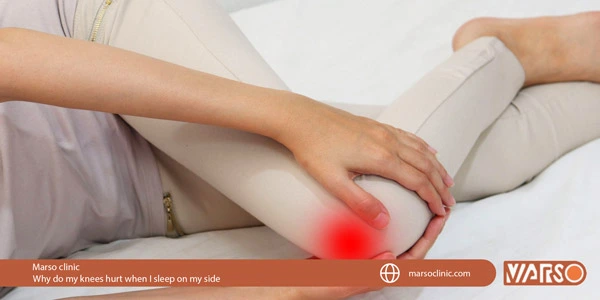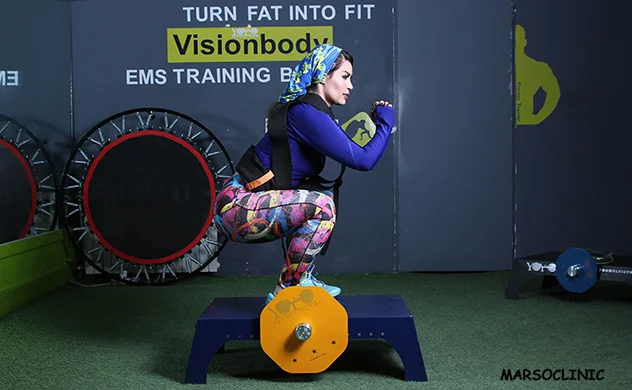
Associate Professor of Orthopedic expert,Brigham Hostpital
If you are one of those people who suffer from knee pain at night while sleeping.
If your knee pain gets worse when you sleep on your side
If you are looking for the cause of knee pain while lying on your side
Read more. In this article, we will say what are the causes of night knee pain and worsening knee pain when sleeping on your side?
Why do my knees hurt when I sleep on my side?
Read more to get the answer to the above question.
This article is recommended for all patients with osteoarthritis or arthritis of the knee.

Wrong body position at any time, even when you are asleep, is associated with increased pain and inflammation in your knee.
If your knee pain intensifies while sleeping in one position, it is necessary to change the painful position of your body.
And be in a position where you do not have pain. Doctors recommend that if you have knee pain while sleeping, you should change your body position, for example, if your knee hurts while lying on your side or your knee pain intensifies in this position, put a small pillow between your knees lying on one side, and if you want, do not experience knee pain the next morning.
Don’t prop up a bent knee on a pillow
Why do we get knee pain when sleeping on our side?
Knee pain is a very common pain among people in the community. Most knee pains have mechanical causes; this means that they are caused by overuse of the joint.
Unfortunately, we have to say that these knee pains get much worse at night, knee pain will prevent you from getting quality sleep and this lack of sleep will make you tired and dull during the day. If you do not know the cause of knee pain, you will certainly not be able to have the right treatment and experience comfortable sleep.
What are the causes of knee pain at night and when sleeping on your side?
Common causes of "nocturnal" knee pain are:
- Runner’s knee
- Osteoarthritis of the knee or degenerative changes of the knee joint:
- Inflammation of the knee bursa or knee bursitis
- Injuries to the knee and structures around the knee joint
Certainly, by determining the cause of nocturnal knee pain, it will be easier and more accurate to provide a rest and treatment plan.
The causes of knee pain "when lying on your side" are as follows:
This pain is very common among athletes and can cause excruciating knee pain at night and when lying on their side. These people feel pain in the back of their patella. This pain can be dull. Sometimes the pain behind the patella of the knee may be pain that spreads around. Sometimes people report feeling tingling around the knee following running or exercising and physical activity.
Runners and jumpers are among the most susceptible to this knee pain, but doctors say a group of people are more prone to runner knee than others.

These people have a structural disorder in their knee and kneecup. Due to these kneecup problems, these people cannot cover and protect the whole joint.
In many cases, if you have this problem, you will be able to get rid of knee pain by stopping strenuous exercise and taking rest and taking anti-inflammatory drugs (CT).
- Knee osteoarthritis or degenerative changes:
By overuse of the knee joint and placing too much weight on the knee, your knee will suffer from joint degeneration and stiffness.
As the pressure on the articular cartilage of the knee increases and the knee is used continuously, there is no time left to repair the damaged soft tissue and the cartilage is not damaged and its height, flexibility and freshness are reduced, the distance between the bones adjacent to the knee joint is reduced and the wear between them is more and more. Cysts and extra bony appendages will form in the bones adjacent to the joint. Sometimes these bony appendages are torn and left in the joint space and get stuck during joint movements between the bones and locking the knee, little by little the knee becomes unstable and you feel that your knee empties when you walk.
Osteoarthritis of the knee manifests as dryness of the knee, knee pain and swelling, and difficulty in knee movements. Unfortunately, the pain and discomfort of osteoarthritis of the knee intensifies at night and when you sleep.
The bursa is a small sac that contains fluid that is placed around the joints of the body to slip and soften the surfaces of wear and movement between the bones and ligaments.
The knee also has important bursae that following continuous kneeling, rapid and unsteady movements of the knee joint, especially without braces and knee protection, the wall of these bursae becomes inflamed. Inflammation will be accompanied by swelling and pain.
Excessive pressure, especially on the wrong axis and direction, can also be accompanied by inflammation of the bursa wall or bursitis.
Trauma and direct traumas to the knee are also associated with bursitis of the knee. So knee bursitis ocurrs like a runner's knee following Overexxertion. In general, the prevalence of knee bursitis is lower than that of runners.
If bursitis is due to an infection, septic bursitis occurs. Septic bursitis can be chronic, acute or recurrent, so if you want to get acquainted with septic bursitis and can septic bursitis kill you read the mentioned article.
Knee bursitis is associated with the following symptoms:
- Inflammation
- In moderate to severe cases of knee bursitis, the inflamed bursa of the knee may be seen and felt as a bulge above the knee.
- Localized heat and pain are other symptoms of knee bursitis.
Another cause of knee pain is knee inflammation, such as rheumatoid arthritis. Fractures of any of the three bones around the knee joint, the femur and tibia, knee dislocation, patellar dislocation of the knee, and stretching of the tendons around the knee can cause knee pain.
In addition, non-infectious cases of infectious knee arthritis, especially in children and immunocompromised individuals such as diabetics and patients with rheumatoid arthritis, should not be overlooked.
Knee pain gets worse at night when you sleep, if you have osteoarthritis of the knee or if you experience bursitis of the knee or Runner's knee, know that unfortunately knee pain in these cases worsens at night. Rest and use of anti-inflammatory drugs and cessation of strenuous exercise will relieve knee pain due to bursitis and runner knee, but knee osteoarthritis will require occasional longer measures to control.
Important tips for reducing knee pain
Here are some tips that will be able to play an effective role in reducing night knee pain:
- Avoid napping in the middle of the day.
- Choose a dark and cool place to sleep at night.
- Avoid overeating before bed.
- Avoid strenuous exercise just before bed.
- If you do not sleep well, be sure to ask your doctor about the possibility of taking melatonin and magnesium supplements.
- Before going to bed, turn off your TV, cell phone and computer, the light of the screens of these devices can disturb your sleep.
- The best position is to lie on your side and be sure to use a small pillow and place it between your knees that are slightly bent.
- Avoid back or knee straining while sleeping.
Sometimes knee pain is a painful and endless pain that is more severe when you have chronic arthritis of the knee such as osteoarthritis or osteoarthritis of the knee. It is important to consult your doctor to reduce the pain and experience a good quality sleep without night knee pain. Without a good night's sleep, your health will be in jeopardy and danger.